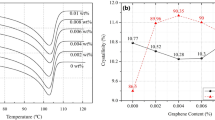Abstract
HVDC cable transmission plays an important role in urban center power supply, large-scale utilization of distributed energy, island and cross sea power transmission. Thermoplastic polypropylene (PP) material has excellent heat resistance and insulation performance, and can be recycled. However, it is not suitable to apply PP directly to the cable insulation for its low temperature impact and brittleness. In this chapter, polypropylene was blended with vinyl elastomer ULDPE to improve its mechanical toughness. The optimal proportion of PP/ULDPE blends was determined by the melting and crystallization behavior, mechanical tensile properties, trap distribution characteristics, space charge, conductivity and breakdown properties of the blends. Then, PP/ULDPE blends with different amount of nano graphene were prepared. The space charge, electrical conductivity and breakdown strength of PP and its nano graphene modified composites at different temperatures were measured and analyzed. Based on the isothermal discharge current method, the trap distribution characteristics of PP/ULDPE/graphene nanocomposites were obtained to study the relationship between space charge, electrical conductivity, breakdown strength and nano graphenen.
Access this chapter
Tax calculation will be finalised at checkout
Purchases are for personal use only
Similar content being viewed by others
References
I.L. Hosier, A.S. Vaughan, S.G. Swingler, An investigation of the potential of polypropylene and its blends for use in recyclable high voltage cable insulation systems. J. Mater. Sci. 46(11), 4058–4070 (2011)
K. Kurahashi, Y. Matsuda, A. Ueda et al., The application of novel polypropylene to the insulation of electric power cable. IEEE/PES Transmission and Distribution Conference and Exhibition, Yokohama, Japan: IEEE, pp. 1278–1283 (2002)
B.X. Du, H. Xu, J. Li et al., Space charge behaviors of PP/POE/ZnO nanocomposites for HVDC cables. IEEE Trans. Dielectr. Electr. Insul. 23(5), 3165–3174 (2016)
B.X. Du, H. Xu, J. Li, Effects of mechanical stretching on space charge behaviors of PP/POE blend for HVDC cables. IEEE Trans. Dielectr. Electr. Insul. 24(3), 1438–1445 (2017)
A.R. Khare, S.P. Westphal, M.T.K. Ling et al., Thermal and dynamic mechanical analysis on metallocene ULDPE/PP blends to optimize impact properties. Thermochim. Acta 357–358, 155–160 (2000)
T.J. Lewis, Nanometric dielectrics. IEEE Trans. Dielectr. Electr. Insul. 1(5), 812–825 (1994)
X. Huang, P. Jiang, Y. Yin, Nanoparticle surface modification induced space charge suppression in linear low density polyethylene. Appl. Phys. Lett. 95(24) (2009)
D. Akinwande, L. Tao, Q. Yu et al., Large-Area Graphene Electrodes: Using CVD to facilitate applications in commercial touchscreens, flexible nanoelectronics, and neural interfaces. IEEE Nanatechnol. Mag. 9(3), 6–14 (2015)
T. Kuilla, S. Bhadra, D. Yao et al., Recent advances in graphene based polymer composites. Prog. Polym. Sci. 35(11), 1350–1375 (2010)
W.Y. Chiu, S.J. Fang, Mechanical properties and morphology of crosslinked PP/PE blends and PP/PE/propylene–ethylene copolymer blends. J. Appl. Polym. Sci. 30(4), 1473–1489 (1985)
Z. Ye-Wen, L. Ji-**ao, Z. Fei-Hu et al., Formation and distribution of space-charge in cross-linked polyethylene. Chin. Phys. Lett. 19(8), 1191–1194 (2002)
G. Chen, J. Zhao, S. Li et al., Origin of thickness dependent dc electrical breakdown in dielectrics. Appl. Phys. Lett. 100(22), 222904 (2012)
T. Maezawa, J. Taima, Y. Hayase et al., Space charge formation in LDPE/MgO Nano-composite under high electric field at high temperature[C]: IEEE, pp. 271–274 (2007)
E.J.G. Santos, E. Kaxiras, Electric-field dependence of the effective dielectric constant in graphene. Nano Lett. 13(3), 898–902 (2013)
T.J. Lewis, Interfaces are the dominant feature of dielectrics at the nanometric level. IEEE Trans. Dielectr. Electr. Insul. 11(5), 739–753 (2004)
M. Roy, J.K. Nelson, R.K. MacCrone et al., Polymer nanocomposite dielectrics-the role of the interface. IEEE Trans. Dielectr. Electr. Insul. 12(4), 629–643 (2005)
S. Li, N. Zhao, Y. Nie et al., Space charge characteristics of LDPE nanocomposite/LDPE insulation system. IEEE Trans. Dielectr. Electr. Insul. 22(1), 92–100 (2015)
L. Zhang, Y. Zhou, J. Tian et al., Experiment and simulation of space charge suppression in LDPE/MgO nanocomposite under external DC electric field. J. Electrostat. 72(4), 252–260 (2014)
F. Tian, Q. Lei, X. Wang et al., Effect of deep trap** states on space charge suppression in polyethylene/ZnO nanocomposite. Appl. Phys. Lett. 99(14), 142903 (2011)
T. Tanaka, Dielectric nanocomposites with insulating properties. IEEE Trans. Dielectr. Electr. Insul. 12(5), 914–928 (2005)
S. Li, G. Yin, S. Bai et al., A new potential barrier model in epoxy resin nanodielectrics. IEEE Trans. Dielectr. Electr. Insul. 18(5), 1535–1543 (2011)
Author information
Authors and Affiliations
Corresponding author
Editor information
Editors and Affiliations
Rights and permissions
Copyright information
© 2021 The Author(s), under exclusive license to Springer Nature Singapore Pte Ltd.
About this chapter
Cite this chapter
Hou, Z., Du, B., Xu, R., Li, J., Li, Z. (2021). The Insulating Properties of Polypropylene Blends Modified by ULDPE and Graphene for HVDC Cables. In: Du, B. (eds) Polymer Insulation Applied for HVDC Transmission. Springer, Singapore. https://doi.org/10.1007/978-981-15-9731-2_5
Download citation
DOI: https://doi.org/10.1007/978-981-15-9731-2_5
Published:
Publisher Name: Springer, Singapore
Print ISBN: 978-981-15-9730-5
Online ISBN: 978-981-15-9731-2
eBook Packages: EnergyEnergy (R0)




